Kindergarten Lessons
Involve me and I learn...
Math Teaching/Learning

KINDERGARTEN PROBLEM SOLVING
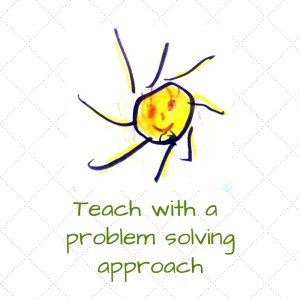
Learning how to approach and solve problems early in life, not only helps children enjoy and look forward to sorting them out, it also helps them make and keep friends.
Preschool and kindergarten problem solving activities give children an opportunity to use skills they have learned previously and give you an opening to teach new problem solving strategies.
Introduce the vocabulary of solving problems with stories, puppets and everyday situations that occur. “We only have 10 apples but there are 20 students. This is a problem . Let’s think of some ways that we can solve this problem ?”
Use terms like, “a different way, let’s brainstorm, that’s a challenge, let’s think of some different solutions”.
How do I develop a problem solving approach?
Asking children questions such as , “How would you…?” or “Show me how you could…?”, help set the stage for teaching with a problem solving approach. Keep problem solving topics about subjects that interest the students. Kids are constantly trying to problem solve as they play.
Students are learning to:
- Identify problems or challenges
- Fact find (what do I know, what have I tried)
- Think of ways to solve the problem (brainstorm, creative thinking, generate ideas)
- Test their ideas
What preschool and kindergarten problem solving strategies can I teach?
Young children need real objects, pictures, diagrams, and models to solve problems. Start with real objects and move slowly to diagrams and pictures. Any of the following problem solving strategies will help them work through the four steps above:
- using objects
- acting the problem out
- looking for patterns
- guessing and checking
- drawing pictures
- making a graph
- teach with projects
Play creates classroom opportunities for problem solving
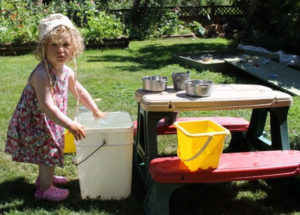
Perhaps a child is getting frustrated as he/she plays with blocks. To help him/her focus on the problem ask questions such as:
- What are you trying to do with your blocks?
- What isn’t working?
- What have you tried?
- Can you think of another way to stack the blocks?
- What else can you try?
Encourage creative thinking
Reinforce creative thinking, not results. The ability to solve problems and think creativity is important.
Talk about the different ways the child tried to solve the problem rather than the outcome. “Joe tried three different ways to stack the blocks. That was a great effort, Joe.”
Social classroom problem solving opportunities are abundant

- Identify the problem – Talk about the problem. For instance, some children may be worried because other kids are hiding the center markers for the play center and giving them to their friends. Other kids are not getting turns.
- Fact find – There are only 4 center markers for the play center because it is small and more than 4 kids would be too crowded. Some kids are hiding them so they can play with the same children each time.
- Brainstorm ideas – How can everyone have turns? What ideas do you have? What could we try?
- Test the idea – Let’s try that idea and meet again tomorrow and see how its working.
Investigating and Problem Solving
Using short periods of time examining and investigating objects, such as feathers or rocks, captures children’s attention and challenges them to inquire, to develop mind sets of being problem solvers and to think independently. Find a sample lesson here…
A Blog About Parenting: Coping Skills, Behavior Management and Special Needs

25 Fun Problem Solving Activities for Kids
Problem-solving activities for kids : Explore 24 fun problem-solving games and activities, and learn effective tips and strategies to teach kids problem-solving skills. If you want to explore problem-solving strategies more in-depth, you can also grab our workbook “ Problem-Solving for Kids ” (printable resource).
Problem-solving is the cognitive process of finding solutions to challenges or complex situations.
A systematic approach to problem-solving tends to include defining the problem, gathering information and data, generating potential solutions, evaluating the pros and cons of each solution, making a decision, and implementing the chosen solution.
Effective problem-solving often requires critical thinking, a good dose of creativity, and the ability to consider multiple perspectives. It may also involve identifying patterns, breaking down a problem into manageable chunks, and applying our logic to develop solutions.
Problem-solving is present in everyday situations and across all fields: business, science, personal life, and education. There is not one single aspect in our lives where we don’t need to apply our problem-solving skills.
Table of Contents
- Problem-solving steps
- Development of problem-solving in childhood
- Benefits of developing problem-solving skills
- 10 Tips to teach kids problem-solving skills
- 10 Examples of problem-solving strategies
- 25 Problem-solving activities and games for kids
Problem-Solving Steps
Some key components of problem-solving include:

- Identifying the problem Recognizing and defining the issue or challenge that needs to be addressed.
- Analyzing the problem Investigating and understanding the underlying causes, factors, and relationships related to the problem.
- Generating solutions Generating potential solutions or strategies to address the problem.
- Evaluating all possible solutions (Pros and Cons Analysis) Assessing the feasibility, effectiveness, and potential consequences of each solution. Considering the positive and negative aspects of each solution.
- Decision-making Selecting the best solution based on our analysis and judgment.
- Implementing the best solution Actioning our chosen solution
- Monitoring progress and results
- Reflecting on the outcomes Reviewing and evaluating the outcomes of the implemented solution, learning from the experience, and making adjustments if necessary.
Development of Problem-Solving Skills in Childhood
Children begin to develop problem-solving skills from a very early age, and these skills continue to develop and refine throughout childhood and adolescence.
Babies soon learn about action and reaction. And, as early as eight months, they begin to acquire an understanding of cause and effect (they shake a rattle, it makes a sound; they push a toy, it falls)
Between 13 and 24 months, they start solving simple problems through trial and error and engage in symbolic play using their imagination.
As children progress into middle childhood (ages 7-11), they develop more advanced problem-solving skills. They become capable of understanding multiple perspectives and can consider multiple factors when solving problems. They start using logic and reasoning to solve increasingly complex problems.
During adolescence (ages 12 and up), problem-solving skills continue to develop. Teenagers can generate and test hypotheses and use deductive and inductive reasoning to arrive at solutions.
Each child will develop their problem-solving skills at their own pace. Some children may show advanced problem-solving abilities at an earlier age. Others may require more time and experience to develop these skills fully.
Benefits of Developing Problem-Solving Skills in Children
Problem-solving skills in children are crucial for children’s cognitive, social, and emotional development. It equips them to approach challenges, think critically, make informed decisions, and find creative solutions.
The benefits of good problem-solving skills in children include:
- Positive impact on self-esteem and confidence Identifying, analyzing, and solving their problems contributes to our kids’ sense of competence .
- Fosters Independence and Autonomy When our kids are able to problem-solve on their own, they take one more step toward independence
- Academic Success Problem-solving skills contribute to academic achievement, as they help students analyze and solve complex problems across various subjects.
- Cognitive Development Problem-solving fosters cognitive skills such as logical reasoning, analytical thinking, and abstract reasoning.
- Critical Thinking Problem-solving enhances critical thinking abilities, enabling children to evaluate information, identify biases, and make informed judgments.
- Creativity Problem-solving promotes creativity by encouraging children to think outside the box, generate innovative ideas, and explore multiple solutions.
- Emotional Resilience Problem-solving skills enhance emotional resilience by enabling children to manage and cope with challenges effectively, reducing stress and promoting well-being.
- Improved Social Interactions/Relationships Problem-solving abilities contribute to better social interactions, conflict resolution , and peer collaboration, promoting healthy relationships.
- Future career success Problem-solving skills are highly valued in the workplace and can positively influence future career success.
10+ Helpful Tips to Teach Kids Problem-Solving Skills
Teaching problem-solving skills to kids is an important part of their cognitive development. It helps them develop critical thinking, creativity, and resilience.
But how can we help our kids and students to develop this essential skill?
We can help our kids and students develop and improve their problem-solving skills in many ways. These are some helpful tips that you could consider:
- Model problem-solving behavior When you see yourself in a problem-solving situation, verbalize your thought process: “I wonder how I should address this issue. I guess my alternatives could be… They all have positives and negatives….”
- Let them participate in the problem-solving situation “Could you help me solve this puzzle?”
- Provide real-life problem-solving situations Real-life scenarios make problem-solving more meaningful for kids. For example, discuss how to resolve a conflict with a sibling or how to make the morning routine smoother.
- Teach them how to break down problems Show them how to break down complex problems into manageable sub-problems.
- Practice brainstorming Create brainstorming situations where all the family (or the classroom) can contribute to solving a problem
- Teach the value of perseverance Sometimes, we must stick to a situation and persevere before finding a solution. Encourage kids to persevere through challenges and setbacks, emphasizing that mistakes and failures are opportunities for learning.
- Encourage critical thinking Encourage kids to analyze situations, consider different perspectives, and evaluate possible outcomes.
- How could we make your school lunch healthier but still yummy?
- How could we reuse/recycle all this paper?
- What could we do to help you remember all the steps in your night routine?
- Encourage reflection When they can find a solution for a problem, don’t jump to solve it for them. Encourage them to reflect on the problem and find and evaluate alternatives. And after a problem is solved, think about the whole process and the learnings. “How did this work?” “What did you learn” “Do you need to change anything?”
- Foster creativity Provide them with opportunities for imaginative play, creative projects, and brainstorming sessions.
- Teach the value of teamwork Teach kids the importance of working together to solve problems. Engage them in group activities or projects that require teamwork and collaboration. This helps kids learn the value of different perspectives and work together towards an objective while they practice their communication skills.
- Teach decision-making skills Teach kids how to approach problems systematically by going through the steps we have mentioned in our first section.
- Encourage both structured and free play. Structured play can help you create good problem-solving situations, while free play will foster creativity.
Developing problem-solving skills is an ongoing process that will also continue in adulthood. Provide your kids with guidance and support, and celebrate their efforts and achievements along the way.

10 Examples of Problem-Solving Strategies
There are different strategies that can help us solve a wide range of problems. Here are some commonly recognized problem-solving strategies:
1 . Trial and Error : This is the first problem strategy that we ever learn. We start using trial and error strategies in infancy, and it continues serving its purpose in many situations. This strategy involves trying different solutions or approaches and learning from the errors or failures until a successful solution is found.
2. Algorithm: An algorithm is a step-by-step procedure or a set of rules that guarantees a solution to a specific problem. It is a systematic approach to problem-solving that follows a predetermined set of instructions.
3. Heuristics: Heuristics are mental shortcuts or rules of thumb that help simplify problem-solving by providing quick and efficient strategies. While heuristics can be effective in many situations, they may also lead to biases and errors.
4. Divide and Conquer: This strategy involves breaking down a complex problem into smaller, more manageable chunks or steps that make the overall problem easier to tackle.
5. Working Backwards: This strategy involves starting from the desired outcome and working backward to determine the steps or actions needed to reach that outcome. We often use this problem-solving strategy when we set goals.
6. Analogical Reasoning: Analogical reasoning involves drawing parallels between the current problem and a similar problem that has been solved in the past. By applying the solution from the previous problem to the current one, individuals can find a solution more efficiently.
7. Brainstorming: Brainstorming gets lots of brains working on the same problem. It is a great collaborative problem-solving strategy that can bring different perspectives and experiences to the table and may result in lots of creative ideas and solutions.
8. Decision Matrix: A decision matrix is a systematic approach to evaluating and comparing different options or solutions. It involves creating a matrix that lists alternatives and the criteria for evaluation. It assigns weights or scores to each criterion to come up with the optimal alternative.
9. Root Cause Analysis: Sometimes, we need to understand what is causing a problem before we can attempt to solve it, as different causes may require different approaches (for example, when you are sick, your doctor may need to understand what is causing the problem before prescribing a medicine)
10. Simulation and Modeling: Simulation involves creating a simplified representation or model of a problem situation to gain insights and test different scenarios.
Our choice of strategy will depend on the problem, available resources, and our own personal preferences and circumstances. We may also need to combine strategies or apply different ones to different aspects of a complex problem.

(Disclosure: We are a participant in the Amazon Services LLC Associates Program, an affiliate advertising program designed to provide a means for us to earn fees by linking to Amazon.com and affiliated sites. You can also read our Disclosure & Disclaimer policy here )
Best Problem-Solving Activities for Kids
Play-based activities are centered around play and are designed to engage children in active learning and exploration. And fun problem-solving activities are a great way to develop children’s critical thinking, creativity, and decision-making skills.
In this section, we will review some problem-solving games and activities that will engage your kids’ critical-thinking skills and creativity.
1. Puzzle Games Puzzles are a fun activity for children of all ages. Young children will enjoy simple puzzles, while older children (and adults!) can have fun with more complex ones. Encourage them to use logical thinking and problem-solving strategies to complete the puzzles.
2. Crosswords A crossword is another fun type of puzzle and a good source of mental stimulation.
3. Sudoku Sudoku is a popular logic-based puzzle that involves filling a grid with numbers.
It can be extremely easy or very challenging, adaptable even for young learners.
Let’s go now for a couple of building challenges!
4. Build the Tallest Tower Give the child a set of materials (Legos, building blocks, wooden blocks, or other construction materials) and ask them to build the tallest tower they can. This simple game will encourage them to problem-solve as they build and figure out how to make the tower stable.
5. Build Towers with Different Materials Ask your child to build three different towers with different materials. Then assess how stable they are and how much weight they can hold. Analyze the pros and cons of using each type of material.
6. Treasure Hunt Set up a treasure hunt with clues leading to hidden objects or rewards. Children will have to follow the clues and solve puzzles to find the ultimate prize. This activity encourages problem-solving, critical thinking, and teamwork.
7. Scavenger Hunt Playing Scavenger Hunt can be a fun way for our kids to put their creative problem-solving skills to good use. Provide them with clues and puzzles that they must solve in order to find the next clue.
8. Mystery Bag Fill a bag with random objects and ask children to come up with creative uses for each item. Encourage them to think outside the box and find innovative solutions.
9. Memory Game While memory games primarily focus on memory retention and recall, they can indirectly contribute to problem-solving skills by developing cognitive abilities such as attention, information processing, and adjusting their strategies.
10. Role-Playing Scenarios Create role-playing scenarios where children have to solve a problem or make decisions. For example, pretend to be stranded on a desert island and ask them to decide what items they will take and how they will survive.
11. Role-Play Social Situations Work in developing social skills with social problem-solving situations.
12. Brainstorming Sessions Choose a topic or problem and hold brainstorming sessions where children can generate as many ideas as possible. Encourage them not to limit themselves (even if alternatives feel unfeasible!)
13. Team Building Activities and Games Engage children in team-building games like building a balloon tower. Each team member will need to collaborate, communicate, and problem-solve together to complete the project.
14. Escape Rooms An escape room is a super fun team problem-solving activity.
In an escape room, participants are locked inside a themed room and must work together to solve puzzles, find clues, and accomplish tasks within a given time limit in order to “escape” from the room.
15. Science Experiments Conduct simple science experiments that involve problem-solving. For example, in the classic “sink or float” experiment, children predict and test which objects will sink or float in water.
Problem-Solving Board Games
There are many board games that will test our kids problems solving activities. These are just a few examples:
16. Cluedo Players must solve a murder mystery by deducing the murderer, the weapon used, and the location of the crime. Players collect and examine clues to eliminate possibilities and make logical deductions.
17. Codenames Another classic game where players are split into two teams and must guess words based on clues from their teammates.
There are many codenames games available, including themes like Disney or Harry Potter.
18. Mastermind Game In this strategy game players take turns setting and solving secret codes
19. Scrabble Scrabble is a classic word game where players form words on a game board using letter tiles.
Kids must use their problem-solving skills to analyze the available letters, consider the best word combination and strategically place those words to score the highest points.
Learning Problem-Solving with Card Games
Card games provide opportunities for kids to develop problem-solving skills such as strategy, memory, pattern recognition, decision-making, and observation.
Just a couple of examples:
20. Uno Uno is a classic card game where kids match cards based on color or number. They need to assess their cards, strategize and make decisions about which cards to play to get rid of their cards while also considering the cards in their opponents’ hands.
21. Go Fish Go Fish is a classic card game where players try to collect sets of cards by asking other players if they have specific cards. Players need to remember which cards they have and make decisions about who to ask and what sets to pursue.
22. Coding Challenges Introduce children to coding activities using platforms like Scratch (or ScratchJr for younger kids), Code.org, or Tynker. Coding involves problem-solving and logical thinking, and children can create interactive stories, games, or animations.
23. Outdoor Problem Solving Take children outside and present them with challenges that require problem-solving, such as building a shelter using natural materials or finding their way through an obstacle course.
24. Problem-Solving Worksheets Help your child follow a systematic approach to problem-solving with these helpful worksheets
25. Goal-Setting Activities for Kids Learning to set goals and make plans to achieve them is also a problem-solving activity. I have several resources to teach kids about goal-setting that I will list below:
- Goal-Setting Activities for Kids
- SMART Goals for Kids
- Goal Tracker Thermometer
Remember to provide guidance and support during these activities while encouraging children to think independently and come up with their own solutions.
Problem-Solving Worksheets

Looking for kid-friendly examples of problem-solving strategies ?
This workbook explores the following problem-solving strategies (with child-friendly examples and activities):
- Trial and Error
- Heuristics (Clever shortcuts)
- Divide and Conquer
- Working Backwards
- Brainstorming
- Decision Matrix
- Root Cause Analysis
- Systematic problem-solving

One Comment
I always look forward to your articles with active interventions. Thank you!
Leave a Reply Cancel reply
Your email address will not be published. Required fields are marked *

Creative Kindergarten
Home » Teach Problem-Solving Skills With an Easy, No-Prep Activity
Teach Problem-Solving Skills With an Easy, No-Prep Activity

Explicitly teaching problem-solving skills to your students will have multiple benefits: easier classroom management , improved social-emotional learning, better self-regulation skills , and so much more. Finding the time and the resources to do it, though, can be tricky. My problem-solving task cards are here to help!
(I have used some affiliate links in this post)
Problem-Solving Task Cards
I wrote 32 prompts with common classroom scenarios. Everything from “A classmate took something out of my hand that I was using. What should I do?” to “I can’t get my jacket zipped up. What should I do?” These are common problems that come up in my classroom, and I know my students need help figuring out how to solve them.

Having task cards with the prompts written out ahead of time helps cut down on my planning time – I just need to pull the ring out, and I am ready to start my problem-solving lesson.
Problem-Solving Digital Slides
Don’t have the time to print them out? Go digital! Pull up the set of Google Slides with the prompts on them, and you can type the strategies that students come up with directly on the slides.
Problem-Solving Whole Group Instruction
I know that my students need to be explicitly taught the skills necessary to become problem solvers. Just like math and literacy skills , problem-solving is something that I want to model and teach my students.
I chose to use a puppet during these lessons (we have some similar to these ones ). I had my students pick a name for our puppet (Lily), and they would help her solve all her classroom problems. My students loved Lily! I often heard students ask each other throughout the day, “What would Lily do?” when they encountered a problem.

After reading a prompt, students would give ideas on how to solve the problem. I would take the time to model what that would look like in our classroom.
This is what it might look like when reading a problem-solving prompt:
Me: “I am not able to open my snack or lunch container. What should I do?” Student: “Get a teacher.” Me: “How can you get your teacher’s attention?” Student: “Raise your hand.” Me: “Once your teacher is there, what words will you use to ask for help?” Student: “I can’t open my container.” Me: “So, we can say something like, “Can you please help me open my container? Thank you!” Great idea! Is there another way we can solve this problem?”
After coming up with our solution, I might even have students act out the parts for their peers. This way, everyone clearly understands how they can be a problem-solver in each scenario.
Become a Problem-Solver
Grab the problem-solving task cards and slide deck so that you can start teaching your students how to become problem-solvers in the classroom!

Leave a Reply Cancel reply
This site uses Akismet to reduce spam. Learn how your comment data is processed .
Discover more from Creative Kindergarten
Subscribe now to keep reading and get access to the full archive.
Type your email…
Continue reading
- Grades 6-12
- School Leaders
Free printable Mother's Day questionnaire 💐!
25 Kindergarten STEM Challenges That Little Ones Will Love
They’re never too young to create and explore!
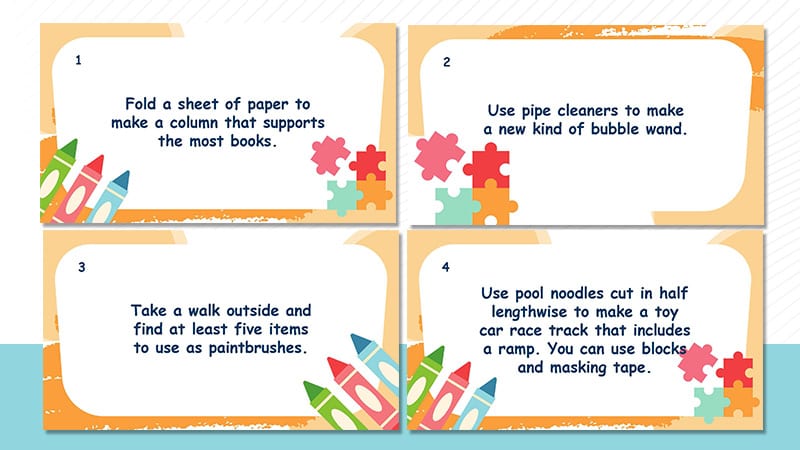
STEM challenges are such a fun way for kids to explore how the world works. By building and creating, they learn problem-solving skills and get hands-on experience with physics, engineering, and more. These kindergarten STEM challenges prove that even little ones have plenty of ingenuity and inspiration.
The best part? These challenges are so easy to set up. They require only basic supplies, like wood craft sticks, pipe cleaners, or blocks. Just post one of these kindergarten STEM challenges on your whiteboard, explain the requirements, pass out the supplies, and watch young minds grow!
Want this entire set of STEM challenges in one easy document? Get your free PowerPoint or Google Slides bundle of these first grade STEM challenges by submitting your email here, so you’ll always have the challenges available.
Just a heads up, WeAreTeachers may collect a share of sales from the links on this page. We only recommend items our team loves!
25 Kindergarten STEM Challenges
Fold a sheet of paper to make a column that supports the most books..
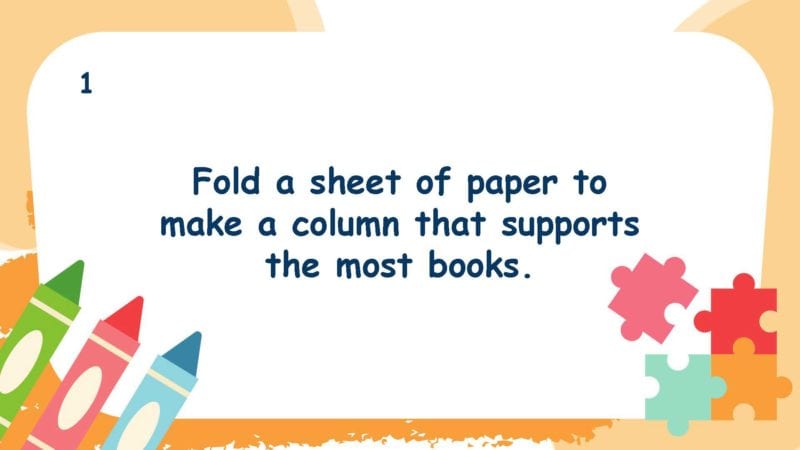
Use pipe cleaners to make a new kind of bubble wand.
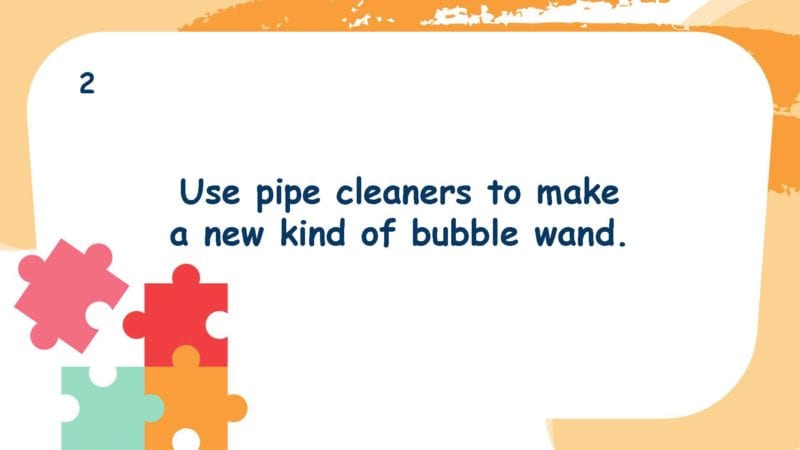
- Zees 1000 Pipe Cleaners in Assorted Colors
Take a walk outside and find at least five items to use as paintbrushes.
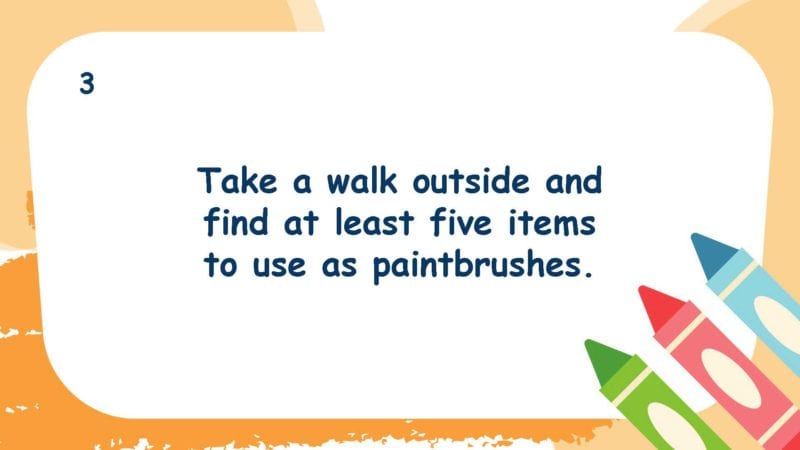
Use pool noodles cut in half lengthwise to make a toy car race track that includes a ramp. You can also use blocks and masking tape.
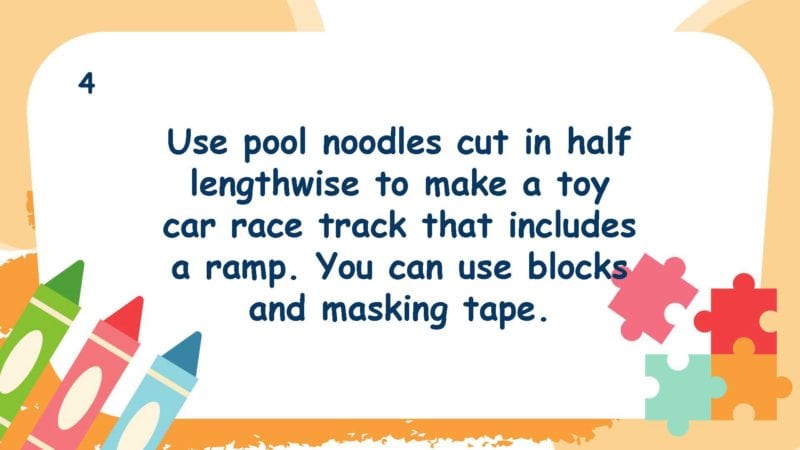
Build the tallest tower you can using wood craft sticks and clothespins.
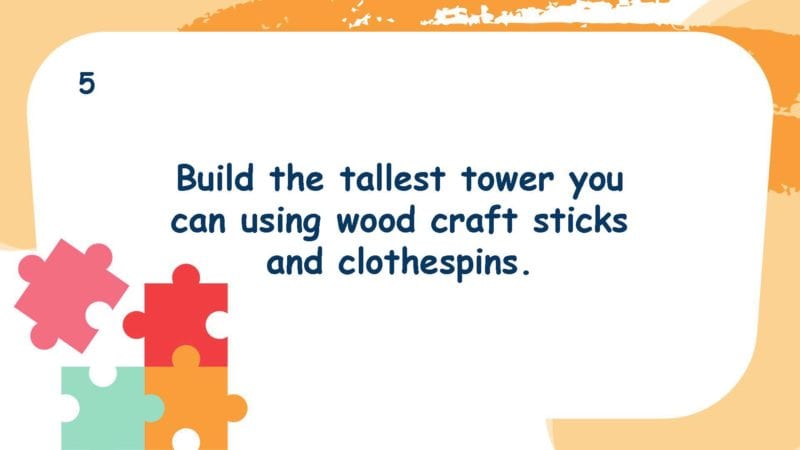
- Whitmore 100 Natural Wood Clothespins
- Pepperell 1000 Natural Wood Craft Sticks
Mix red, blue, and yellow finger paints to make as many new colors as you can.
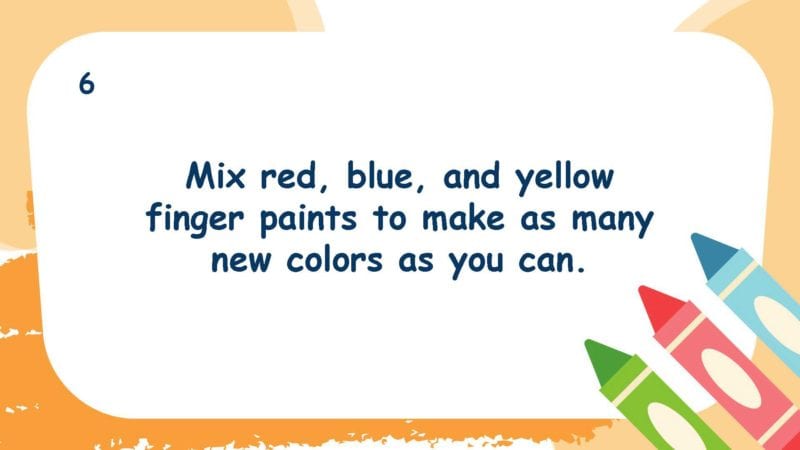
Use toothpicks and marshmallows to make as many different shapes as possible.
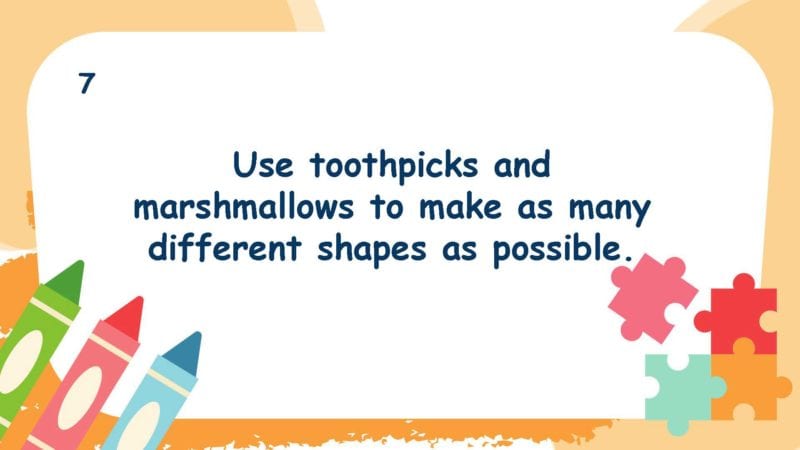
- 1000 Count Natural Bamboo Toothpicks
Use one can of shaving cream to build the tallest structure you can.
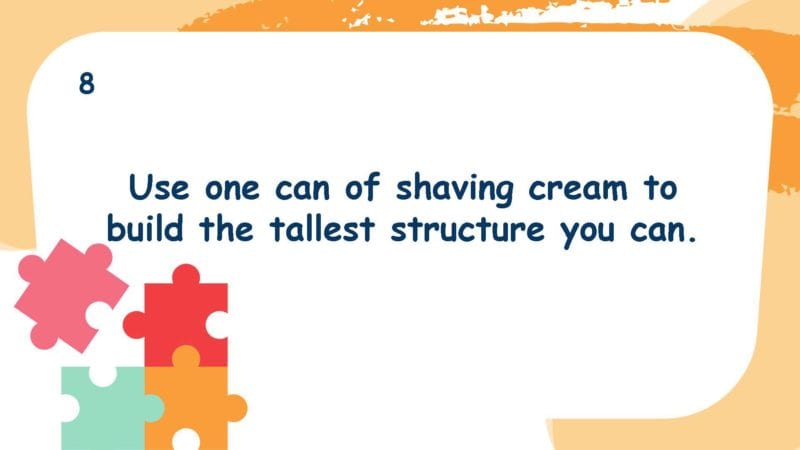
Stack 15 plastic cups into the tallest tower possible.
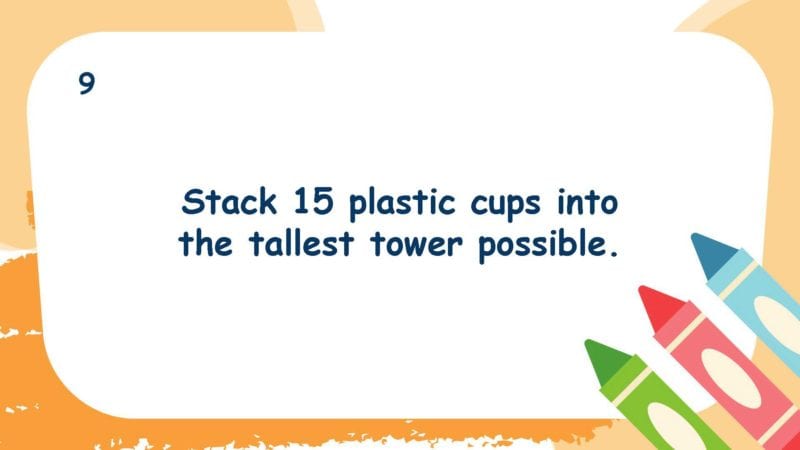
- Clear Disposable Plastic Cups, 500 Pack
Gather twigs outside and use them to build a house for one of the Three Little Pigs.
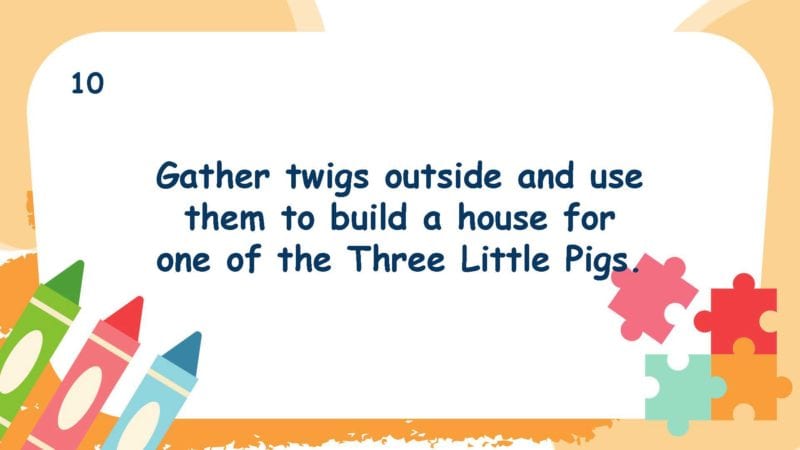
Use 5 pipe cleaners to make the longest chain you can. The chain must be able to hold a small cup of jellybeans.
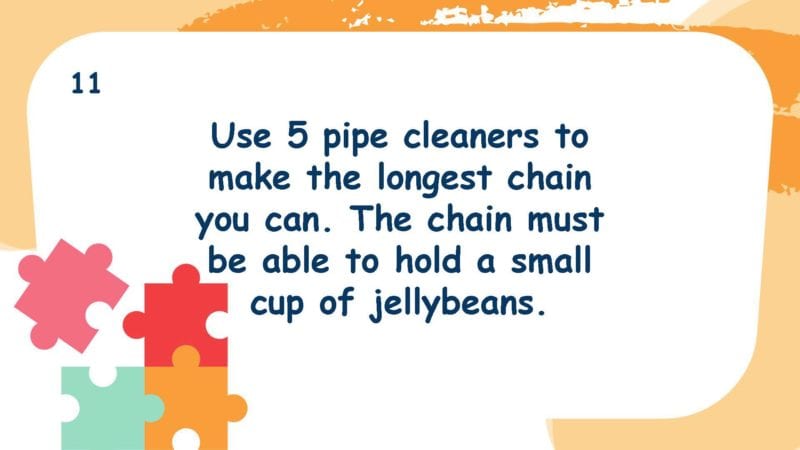
Build the tallest tower possible using buttons and Play-Doh.
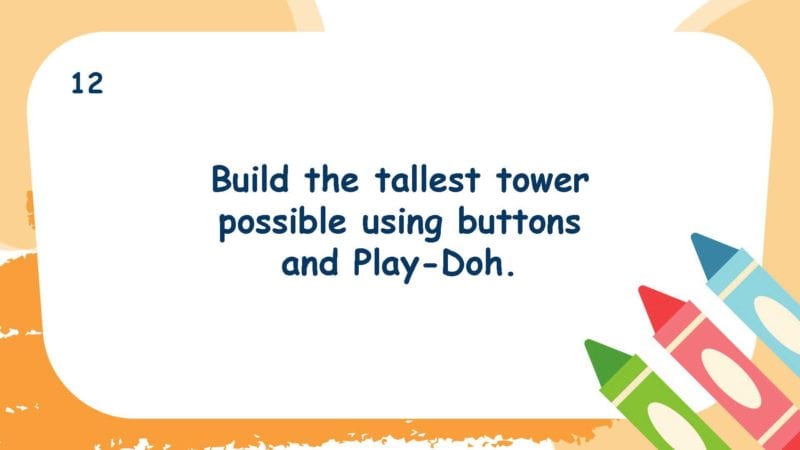
Use a cardboard box, wood craft sticks, construction paper, and supplies like scissors and glue to build a monster trap.
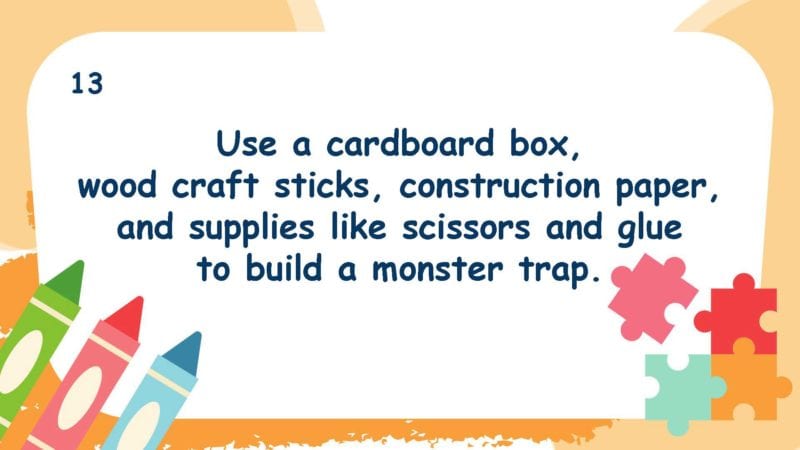
Make a domino chain reaction that includes two curves.
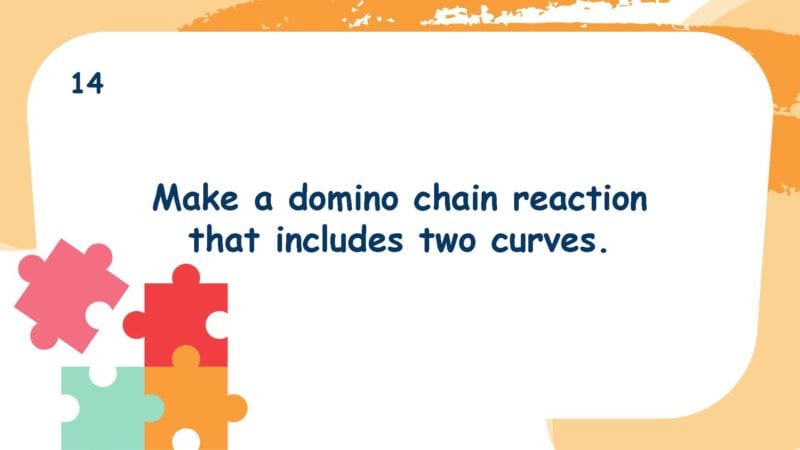
- Lewo 1000 Pcs Wood Dominoes Set
Use newspapers and masking tape to make a tent for a stuffed animal.
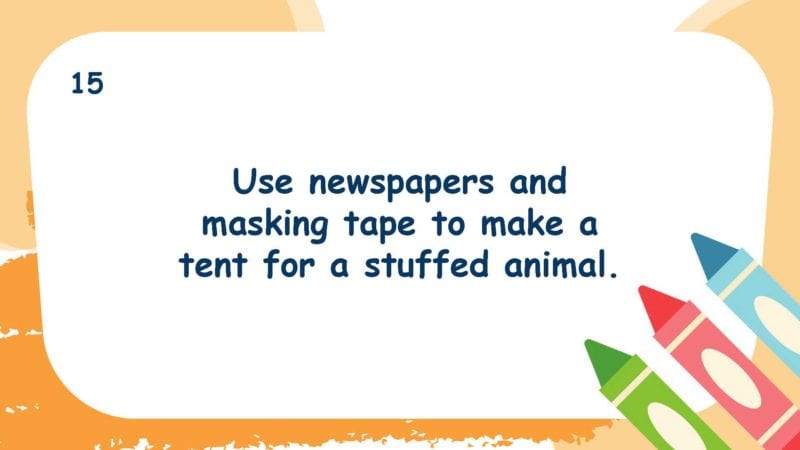
Build a bridge that can hold 100 pennies using wood craft sticks and toilet paper tubes.
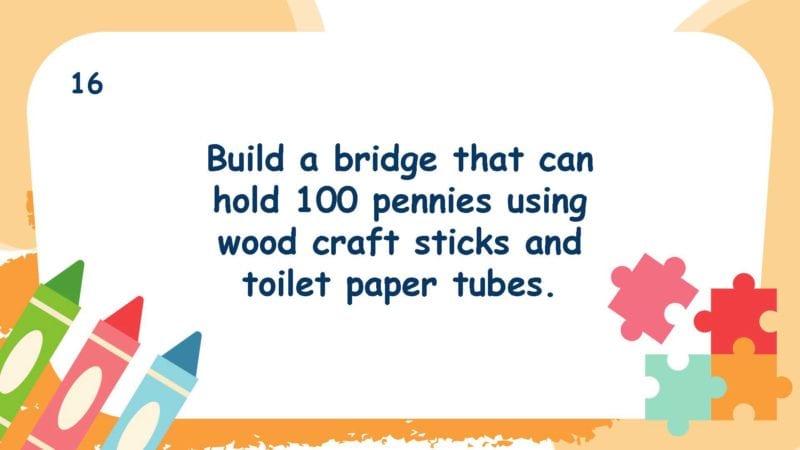
Scoop up one cup of random LEGO bricks and use it to make a new kind of animal.
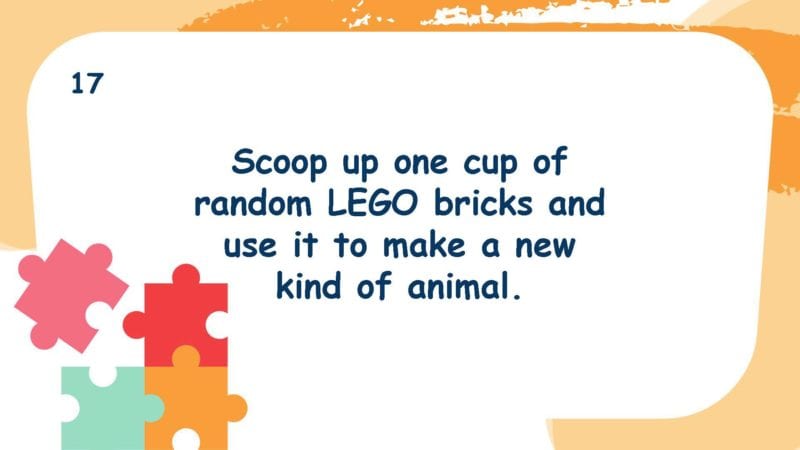
Use plastic straws and masking tape to build the tallest possible tower.
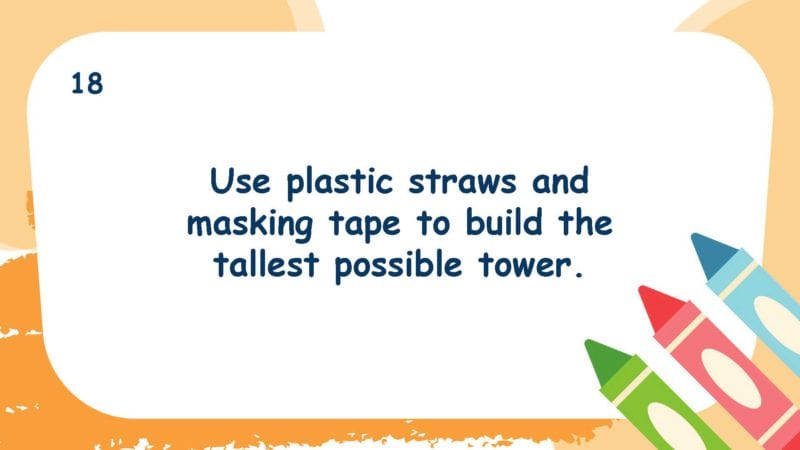
- TOMNK 500 Multicolored Plastic Drinking Straws
- Lichamp 10-Pack of Masking Tape 55 Yard Rolls
Design a repeating pattern necklace from Cheerios and colored beads.
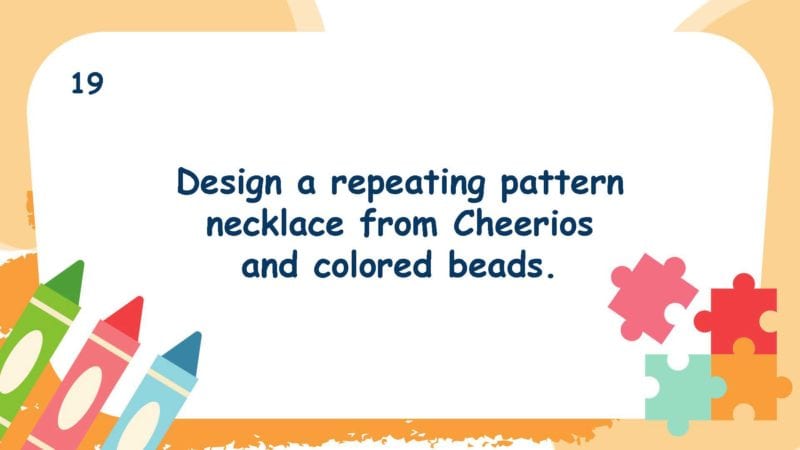
Find three different things to fill plastic eggs to make them sink to the bottom of a tub of water.
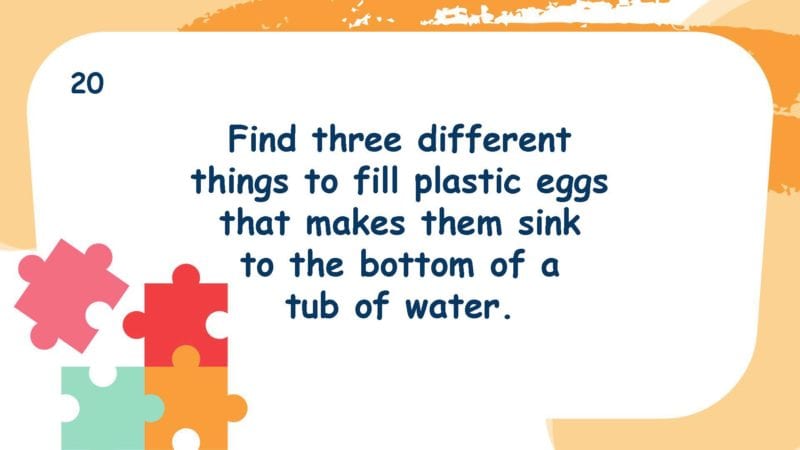
Make a snowflake from toothpicks and mini marshmallows.
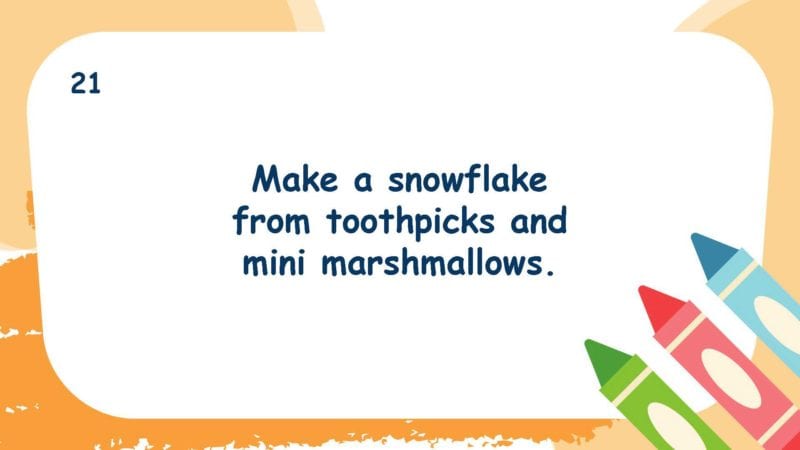
Chicka Chicka Boom Boom! Use blocks and wood craft sticks to make a coconut tree that holds as many alphabet magnets or beads as possible.
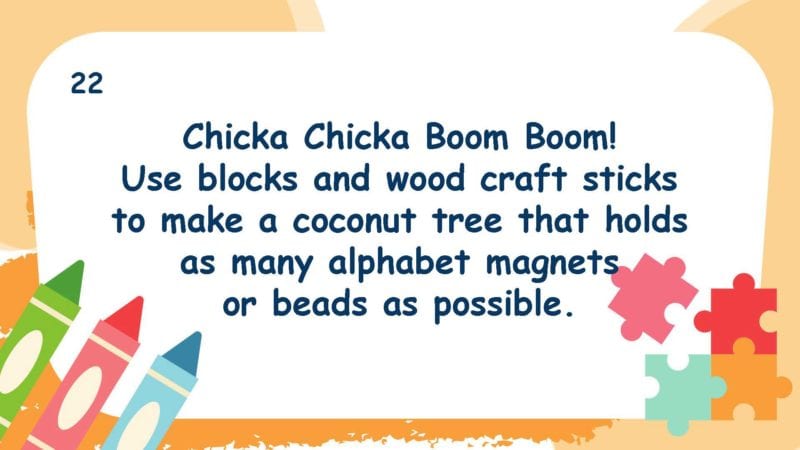
Construct a house from drinking straws and Play-Doh. You can cut the straws if you like.
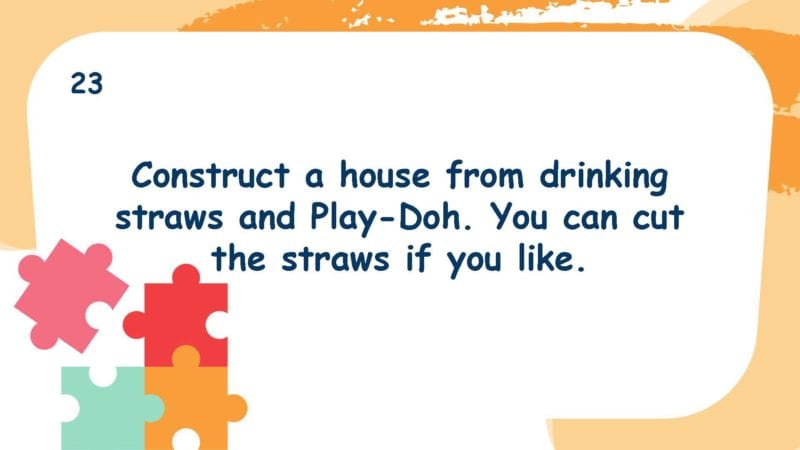
Build a fence for toy animals using wood craft sticks and Play-Doh.
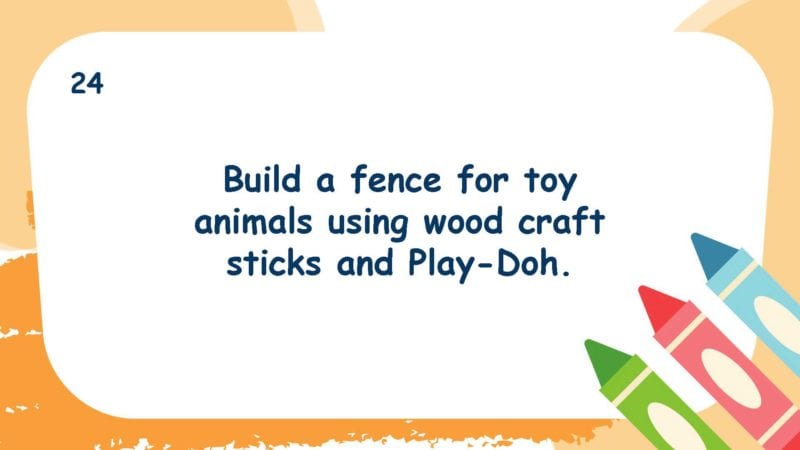

100 Day Challenge! Use 100 of something (blocks, LEGO bricks, pipe cleaners, etc.) to make a creation that celebrates your 100th day of school.
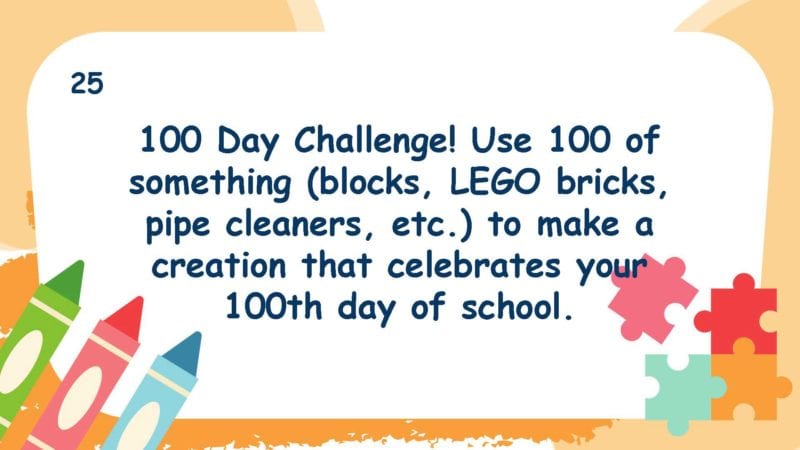
Loved these kindergarten grade STEM challenges? Check out the 23 Best Kindergarten Science Projects and Activities .
Plus, 50 easy science experiments kids can do with stuff you already have ..
Get My STEM Challenges Now!
You Might Also Like
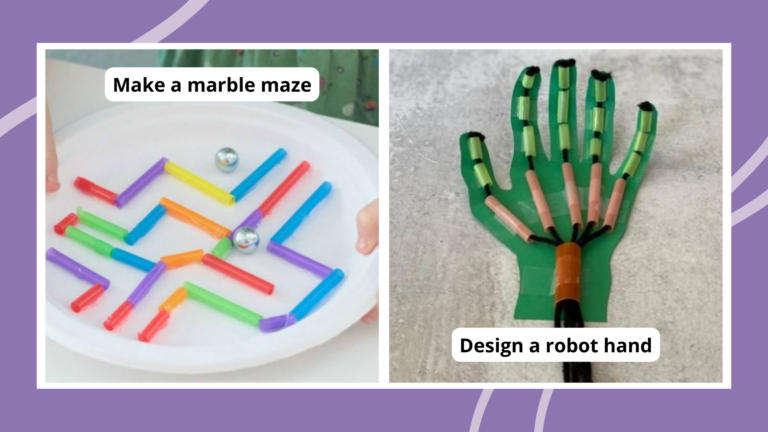
50 STEM Activities for Kids of All Ages and Interests
Inspire the innovators of tomorrow. Continue Reading
Copyright © 2024. All rights reserved. 5335 Gate Parkway, Jacksonville, FL 32256

17 Fun Problem Solving Activities for Kids
There might be affiliate links on this page, which means we get a small commission of anything you buy. As an Amazon Associate we earn from qualifying purchases. Please do your own research before making any online purchase.
As a child, I would spend hours putting together puzzles… whether it was 3-D puzzles or figuring out a crossword. I also loved it when teachers would give the class an open-ended question and we had to work in groups to figure out the answer in our own way.
Even something as simple as playing checkers with my brothers gave me the chance to use strategy as a way to win the game. I honestly believe that it’s so important for kids to solve problems at a young age, as it helps them think critically and outside the box.
Table of Contents
So, Why Is It Important To Teach Kids Problem Solving?
I think these kinds of activities are so important for kids to do because it helps them learn how to think analytically and solve problems on their own. It's a great way to get kids to use their imaginations and be creative.
Rote memorization simply does not have the same effect. This type of learning is great for learning facts like historical dates, but it’s not going to help kids figure out how events in history happened and the results.
We take these problem-solving skills into college, the workforce, and travel . My ability to problem solve since childhood has certainly got me through many sticky situations while in a new city or country.
Additionally, problem-solving helps children learn how to find creative solutions to challenges they may face both in and out of the classroom . These activities can also be fun and used in cohesion with school or playtime.
17 Fun Problem-Solving Activities for Kids
1. marble mazes.
This activity was selected because it requires them to think spatially. Spatial learning will benefit kids when they start driving, riding a bike, playing sports,etc.
To do this activity in its simplest form, you will need a piece of paper, a pencil, and some marbles. First, draw a maze on a piece of paper using a pencil.
Make sure to create a start and finish point. Then, place the marbles at the start of the maze. The goal is to get the marbles from the start to the finish by tilting the paper and using gravity to guide the marbles through the maze.
Another example of a marble maze can involve using toilet paper rolls taped together to create a three-dimensional maze. The larger the maze, the harder you can make it.

Check Price on Amazon!
If you are not into the DIY method, you can always buy a toy maze on Amazon. A good 48 piece puzzle is the Melissa & Doug Underwater Ocean Floor puzzle.
2. The Tower Challenge
Building a tower gives kids the chance to think about gravity, structure, and balance.
To do this activity, you will need some building materials like legos, blocks, or even toilet paper rolls. The challenge is to see how high they can stack the materials without the tower toppling over.
This can be done individually or in teams. An activity like this is good for younger kids and is the building block to learning about harder topics like engineering.
3. The Egg Drop Challenge
The egg drop challenge helps kids learn how to engineer a solution that prevents something from breaking. It requires them to think critically about which materials will best protect something fragile like an egg when dropped from a height.
To do this activity, you will need some eggs and various materials such as straws, cotton balls, bubble wrap, etc. The goal is to construct a device that will protect an egg from breaking upon impact.
This can be done individually or in teams . Teams can even have a competition for the best egg drop device.
As children begin handling, shopping for, and cooking their own food, activities like this will help them understand how to handle breakable items like bottles, eggs, delicate fruit,.etc. Ideally, this is best for age groups 8 and up.
4. The Penny Drop Challenge
This activity was selected because it requires kids to think about physics and how different materials affect sound.
To do this activity, you will need a penny ( or another coin), a cup, and various materials such as paper towels, cotton balls, etc.
The goal is to drop the penny into the cup without making any noise. Begin by placing different materials into the cup and then drop the penny into it. The children should also drop the penny from different heights into the same material to see if/how the impact from a higher drop affects sound.
Group kids into teams or let them try it on their own.
Kids should make note of what type of sounds are made when the penny hits different materials. This is a great activity for kids who are interested in science and physics.
5. The Balloon Race Challenge
This activity was selected because it helps kids learn about aerodynamics and Bernoulli’s principle . It also requires them to think creatively about how to design a balloon-powered vehicle.
To do this activity, you will need balloons, straws, masking tape, and markers. The goal is to design a balloon-powered vehicle that can travel a distance of at least 10 feet. Kids can begin this activity by sketching out their designs on paper.
After they have a basic design, they can begin building their vehicle from various materials. Then kids can explain why they think the balloon traveled or did not travel as far as it did.
6. The Marshmallow Challenge
Marshmallows are not only delicious, but they are also soft and malleable. So kids can have fun using it for some construction projects.
This activity was selected because it requires kids to think creatively about how to build a structure using limited materials. It also helps them learn about engineering and work as a team.
To do this activity, you will need marshmallows and spaghetti noodles. The goal is to build the tallest free-standing structure possible using only marshmallows and spaghetti noodles. If you don't have spaghetti noodles, use something similar like pretzel sticks.
You may even want to establish certain rules like each team can only use a certain number of marshmallows or noodles. A time limit can also make it more fun and challenging.
For more fun activities, check out our post on problem solving exercises for team building .
7. The Balloon Pop Challenge
If you remember your childhood, you probably remember popping balloons for fun at times. But this activity is different because it requires kids to use strategy and critical thinking.
This activity was selected because it helps kids learn about patterns and problem-solving. It is also a lot of fun for kids who like popping balloons. The goal is to create a device that will allow them to pop a balloon without using their hands.
To do this activity, you will need balloons and various materials such as straws, string, paper clips, etc.
8. Picture Pieces Puzzle Game
As mentioned earlier, puzzles are a great pastime – especially in childhood. Kids must think critically about how to put the pieces together to create a certain picture. It also helps them learn about shapes, colors, and other concepts.

You can take a medium to large picture and cut it into pieces. If you have younger kids, you may want to make the pieces larger. However, if you have kids closer to the 8-11 age range, you should be able to provide a challenge and make the pieces smaller.
9. Copy the Block Model
For this challenge, you can build a model out of blocks for the kids to copy. Put kids into groups and make sure each group has the same number of blocks you used for your model.
Make your model block as simple or complex as needed for your child's age group.
Set a time limit and make sure each group starts at the same time.
10. Team Scavenger Hunt
A scavenger hunt is great for kids because they have to search for items and use investigative skills. It is also a lot of fun and can be done both indoors and outdoors .
To do this activity, you will need to create a list of items for the kids to find. The items can be anything from common household items to things you would find outside.
These types of activities can also revolve around a theme like a holiday, movie, or book. For example, if the kids are fans of “Harry Potter” you can make a list of items to find that are related to the movie.
11. Obstacle Course
This activity requires kids to think creatively about how to get from one point to another while maneuvering around obstacles. If you have outdoor space, this can be done with common objects such as hula hoops, cones, etc.
If you don't have access to an outdoor space, you can use common household items to create an indoor obstacle course. For example, you can use chairs, blankets, pillows, etc.
Begin by setting up the course and then timing each child as they complete it. You can also have them race against each other to make it more fun.
Obstacle courses are also great because kids get to be physically active while they are thinking critically.
12. Reading Storybooks
There are many great benefits for kids that read storybooks. One of the excellent benefits is the ability to problem-solve. When they read the stories in the books, they see scenarios that cause them to be attached to the various characters they read about.
So, when they encounter a real-life problem, it is often productive to ask a child how their favorite character would solve that problem. Your kids can also be encouraged to come up with various options and possible outcomes for some of the situations they may encounter.
This not only helps kids solve various problems but become more independent as well.
13. Ask Them Open-Ended Questions
A good way to improve a child's ability to think critically and creatively and improve their ability to solve problems is by asking open-ended questions. It also helps them to develop healthy personalities .
There are no right or wrong answers to these questions. In addition, the solution requires more than a simple “yes” or “no” answer. Furthermore, it allows kids to put some extra thought into their responses.
Here are some examples of open-ended questions you may want to ask.
- What did this experience teach you?
- Was this easy? What was easy about it?
- What this difficult? What is complicated about it?
- What may happen next in this situation?
- How did you come to this solution?
- What, if anything, would you do differently next time?
- What can we do to make things more fun next time?
14. Build Various Structures with Toys
Whether wooden blocks, LEGO blocks, or engineering blocks… giving your kid blocks to build whatever their minds can dream up is fun. In addition, it requires them to think about how they will make a structure, put the pieces together, and creatively ensure the building's function and design.

You may also want to challenge them to build something more complicated and watch them use their brain power to make it happen.
15. Acting Out Skits
Impromptu activities like acting out skits help kids identify problems, develop solutions, and execute them. This process works with multiple kids being divided into teams.
First, you will want to write down different situations, such as resolving a disagreement between siblings or dealing with bullying on the playground on a piece of paper. Second, you will fold the paper and place it in a hat or bowl.
Third, each team will pick a scenario out of the hat. Finally, you can give the kids a few minutes to discuss their solution and act out.
16. Solving Moral Dilemmas
In this simple game, you will help your kids solve simple dilemmas they may find themselves in. You could write down a situation your child may find themselves in and help them learn the moral way to solve the problem.
For instance, “The cashier gave them an additional $5 change back on my purchase. What should they do?” Another scenario could be, “I saw my friend cheating on a test. Should I tell on them or let it go?” A third one could be, “I caught my friends stealing some gum from the store. What should I do?”
After writing down the dilemmas and placing them in a bowl, get each child to select one and read it aloud. Finally, you will help them devise morally correct solutions to the moral dilemma.
17. Animal Pairing Game
This is a fun and creative game to help your kids with focus, critical thinking, and team building skills . In addition, this activity requires an even number of players to participate (4, 6, 8, etc.)
Before starting the game, you will want to write the names of different animals twice, each on a separate slip of paper. Then pass out the slips of paper to each individual or team member, instructing them not to share with anyone the name of the animal they received.
Then the children will perform activities the animals might do without talking or making sounds. Some of these activities might include:
- The way the animal cleans or grooms itself
- The way the animal sleeps
- The way the animal fights
- The way the animal eats or drinks
- The way the animal walks or runs
The goal is for each child to successfully pair up with the other child who has selected the same animal.
How Problem Solving in Childhood Helps in Adulthood
Children are not born with problem-solving skills. It is something that needs to be learned and developed over time .
From babies who learn how to communicate their needs to toddlers who figure out how to get what they want, to children who are starting to understand the consequences of their actions – problem-solving is a process that begins in childhood and continues into adulthood.
Some of the benefits of teaching problem-solving skills to children include:
- Improved critical thinking skills
- Better decision-making skills
- Enhanced creativity
- Improved communication and collaboration skills
- Increased confidence
There are many ways to teach problem-solving skills to children. The activities mentioned above are just a few examples. It is important to find activities that are appropriate for the age and abilities of the child.
With practice, children will develop these skills and be better prepared to face challenges in both childhood and adulthood.
Final Thoughts About Fun Problem Solving Activities For Kids
These are just a few ideas to get you started on teaching your child crucial problem solving skills. Perhaps they’ve inspired to come with some of your own, or seek out others? The important thing is to make sure the activity is age-appropriate and challenging enough to engage the kids.
Problem-solving skills are important for kids to learn because they can be applied to various situations in life. These skills also promote critical thinking, which is an important life skill.
There are many other problem-solving activities for kids out there. In time, you’ll find the ones that work best for your child. And be sure not to forget about your own needs and self-improvement, both of which will make you a better parent and mentor. Here are some useful activities for adults to get your started.
Finally, if you want to level up your parenting skills, then check out this resource that will show you how to get your kids to listen WITHOUT yelling, nagging, or losing control .

Atlas Mission
Navigate to...
5 kindergarten problem solving activities your kid will love.

Want to Improve Your Child's Problem Solving Skills?
Enroll your child for the Atlas Mission – the ultimate learning companion for kids.
Ohhh, problem solving skills. It’s one of those, you know, really, super, important things that all kids are supposed to be learning, or else, they are doomed for life.
I mean, at thirty-one years old I still haven’t figured out how to keep things from spilling everywhere or how to make sure evil Legos aren’t out and about just waiting to deal those excruciating blows to my feet.
I know you’ve been there – i.e. stepped on a car and almost broke your back – and thought about throwing all the darned things in the trash.
But before you do that, here are 5 kindergarten problem solving activities for kids that will make you feel a little better about keeping them around… at least for a little bit longer.
1. Free Building Play
So after I resist the urge to whip into a crazy, toy-trashing whirlwind come across toys the kids have left out, I put them in a building box.
If you don’t have something similar, you can just let your little darling gather up any and all safe objects around the house he would like to use to build something with.
It can be anything. We have had conglomerations of Legos, boxes, wheels/fixtures from random, old pieces of furniture, PVC piping, etc. The point here is to foster open-mindedness… to see random objects in new ways.
Don’t be afraid to frame the problem for him to stretch those skills – “Oh, you built a house? Wow! What if more people needed to fit in it?” Or, just thinking out loud here, “What if Mommy needs a spa room?”
Pro Tip: Help Your Child Become Better at Problem Solving
Enroll your child for the Atlas Mission and let your child play with this award-winning educational program. Your child will become better at problem solving without even realizing it!
2. Rolling Dice
One of my other favorite things to step on in dark hallways.
Kids love to roll dice. I would just feel like a jerk if I didn’t say there are a ton of games kids make up and play with dice that are great for problem solving and general math skills, so let them play freely with them.
Here is one of the best ones I’ve found specifically for problem solving skills.
First, write down a few categories of things – colors, animals, places, people, etc. – on some index cards, or if you are always missing cool school supplies like index cards, card-sized pieces of paper will do just fine. Put them in stack face-down between you and your kid.
Now, for the fun part! Tell your kid to draw a card and roll the die – probably just one die for this game… really… you don’t want any nervous breakdowns here.
He has to think of that number of things that fit into the category he drew. So if he drew the card “Animals” and rolled a three, he might say, “hippo, dog, and rooster.”
This encourages a different kind of open-mindedness that is solution-oriented, rather than going in all directions.
3. Build a Racetrack
Yep, I know. It’s always right in the middle of the way, right? Well, stuff down that gut reaction to “accidentally” knock it over (totally kidding, I know you would never do that, right? Right? :-)), and let them build it (safely) however they want.
After they are done racing their cars down it for a bit, encourage them to actually talk about what they like and dislike about the track.
And then let them build it again… and again. Wait! Don’t run yet – there’s a good reason, promise! While building open-mindedness is a vital first step, experimentation is just as important.
This is where they learn to make predictions and test them to make adjustments.
4. Make a Mosaic
If your brain is frazzled just reading about the previous three activities, this one’s for you! If you already have some of those math pattern/shape blocks, this is the easiest (though it might not get the Legos off the floor, sorry!).
Just give your little one a prompt for a picture, and let her go to town creating it with the pattern blocks. Boats, flowers, houses, and monsters are all good prompts for kindergarteners.
If you don’t have pattern blocks or you want a more permanent creation, you can cut shapes out of construction paper. If you can match the typical pattern block color/shape, it will familiarize your kid with them if she hasn’t seen them in school yet.
Then, go on the same way, letting her create to her heart’s content, finishing with glue if she wishes!
This is about helping her understand that not only are there multiple options to consider when solving a problem, but also sometimes there are actually multiple possible solutions.
5. Roleplaying
Don’t neglect the need to practice problem solving skills for social situations. Most of the problems adults deal with are ones that involve some social aspect, after all. So bust out those costumes (or sheets, old curtains, whatever), and do some roleplaying.
If your kid has a bent for imaginative play, you might be able to just follow along with her plot and ask questions at the right moments, but otherwise, you might have to search your inner-child for a problem that your kid would be interested in enough to make the play effective.
“I want to have a tea party for all the little children in the land, but I don’t know how to do it. What do you think we should do first?”
“There’s a dragon in a cave nearby, and everyone is afraid he might hurt them. What do you think we should do first?”
What? My inner-child is pretty typical, don’t judge!
So put your mind (and feet!) at rest – these kindergarten problem solving activities can keep kids thinking for hours over a variety of different problem solving situations.
It’s even more awesome if brothers, sisters, or friends can participate, so you can just keep an ear on things… while eating chocolate away from prying eyes. (Hey! A problem I did solve!)
Facebook Pinterest Google+
Related Articles
Fun Preschool Problem Solving Games to Encourage Independence
The 8 Best Problem Solving Strategies for the Preschool Mind
10 Kindergarten Problem Solving Skills for your Little Champ
More Preschool and Kindergarten Problem Solving Articles...
Popular Articles
10 Sneaky Ways to Trick Your Kids into Learning Math
First Steps Towards Coding for Preschoolers: Understanding Instructions
5 Ways to Kill Your Child’s Creativity
10 Ways to Supercharge Your Child’s Science Skills

About the Author
Danielle Rhymes creates educational content for the Atlas Mission . She is a stay-at-home mom who is passionate about education. When not chasing down or instilling life lessons in little ones, she also enjoys crocheting, chocolate, and Good Housekeeping.

Liked this article? Don’t miss our next one.
Our blog publishes free tips for busy parents like you to help you improve your child’s Reading, Math, Science and 21st century skills.
Follow us and get weekly updates containing some of our most exclusive content.

- Mar 1, 2023
Building Thinking Classrooms in Mathematics Tasks for Kindergarten!
Updated: Nov 7, 2023
I’m still in the experimentation phase of BTC. I’m trying to see what works best for my students, the types of tasks, manipulatives, creating partnerships, and more. You can learn more about how I started Building Thinking Classrooms in Kindergarten and my update here .
If you'd like to jump right to the tasks click here!

Finding Tasks
I’ve found inspiration for my tasks from the Building Thinking Classrooms book as well as from youcubed.com and NRICH.org , with some 3-Act-Tasks sprinkled in, with that being said, it has been a challenge to find tasks appropriate for Kindergarten when some students have not yet developed their concept of number (Identifying, knowing the quantity, and the number sequence). You can try a free task here!
Presenting Tasks
Getting into character and really selling a story to go along with the task increases engagement in my students. I also have to be purposeful with the manipulatives I use because if they are too fun and its a toy 🤦🏽♀️. (The only exception is when doing a counting collections session when the kids are motivated to count their collection to get to different bags and manipulatives). I may use some slides or visuals sparingly to clarify or if a visual is part of a task but the majority of what the kids need to know is given verbally, especially since a lot of Kindergarteners are still learning how to read.
Random Grouping and Finding a Space
My first “task” was more about understanding the procedure of getting a random partner, finding the right space to work, and sharing the marker. To create groups I used these free matching color cards with a corresponding space in the room. I wanted the kids to see that the grouping was random and find the appropriate space. The numbers also helped when I moved to using Classroom Screen to generate groups if we were low on time. The task my students had was to draw on the whiteboard only and share the marker with their partner. I noticed they did a great job sharing the marker but were not working together to draw they were just in the same space.

Examples of Tasks I’ve Used
Building a tower together.
To get the kids working together toward a common goal, I gave each pair of students the same number of wooden blocks and their task was to build on structure together (a tower, castle, bridge etc.) They did really well and were motivated to build, one or two groups needed reminders to build together and not two separate structures.
Drawing a Picture Together
After the success of the tower building, their next task was to create a picture together on the board. It was still a bit of a challenge for them so I stopped them mid-session to model what it might look like to decide on one picture and add items to it, they were much more successful afterward.
How Many Are There?
This task I separated this into two parts. I gave each pair a bag with magnets and the first part of the task was to count the items and decide how many there were. There were 10 or below in each bag since it was the beginning of the year. The second part of the task was to show how many there were. The students naturally wrote numerals to go along with their count, labeling each magnet or only writing the total.

This task was adapted from 3 Block Towers from NRICH.org. In this task , the students are given three cubes of different colors and asked to find all the combinations of colors there could be in a tower. I have used this task in the past but keeping in mind the storytelling suggested in BTC I decided to spice it up. The story was, “Once upon a time, there were 3 princes who were brothers, the red prince, the green prince, and the blue prince. Each prince decided they wanted to be on top of the tower. After a lot of discussions, they decided that they should each get a turn on the top, as the middle and the bottom of the tower. What are all the different combinations of colors on the tower are there?” I added a visual of the same and different before getting them in groups and having them start. They recorded their answers with crayons and this recording sheet. As a thin slice or extension for groups, I asked what would they look like if their sister Princess Yellow wanted a turn too. They received a yellow cube and crayon and flipped their recording sheet to the back where the spaces were. The students were very engaged in this task and worked for 30 minutes straight without me! This a great non-curricular task to start with you can also get them HERE on the website store !
How Many Squares?
This task was adapted from the BTC book, starting with fewer squares than the original. The students had to figure out how many squares were on the page. They had trouble understanding that 4 small squares could also be seen as 1 big square that could also be counted. They also had trouble getting past the fact that there were more than nine squares. (I later gave them a similar task with more squares and they did better with it) I used these slides to set up the task and two different recording sheets for thin slicing that included a brief review of what a square is at the features of it before they started working. You can also get them here on the website store !
Which is Greater?
This task is adapted from the BTC book. In this task, 7 and 8 are in a tiff. 7 thinks he is more, but 8 disagrees. They need your student's help to settle this dispute. Which is bigger or greater, 7 or 8. This task is a great opportunity for students to get help from others or help other students if they finish.

What Comes Next?

I used this task when we had been learning about growing patterns. This task can be found at gfletchy.com called the 5 Stage Series . This task shows students a series of three pictures of inch tiles arranged in a growing pattern. The task then asks the students what the fourth arrangement or stage would look like, then the fifth. This can be thin sliced by asking for progressively higher stages. For this task, the students had access to inch tiles if they wanted to build the stages before drawing their answers. Get the slides here on TPT or HERE on the website store!
Which tasks will you try? If you have any tasks that you’ve tried please let me know!
Get the Bundle of all the tasks here on TPT , or HERE on the website store !

This post may contain affiliate links
- Problem Solving In Kindergarten
- Lesson Planning
Recent Posts
Thinking about Building Thinking Classrooms in Mathematics? Start Here!
Building Thinking Classrooms in Mathematics in Kindergarten: One Year Later
UPDATE: Building Thinking Classrooms in Mathematics in Kindergarten

Kindergarten
Problem solving and innovating, kindergarten program overview.
In Ontario, the Kindergarten program is made up of four “frames”, or broad areas of learning. This frame captures children’s learning and development with respect to:
- exploring the world through natural curiosity, in ways that engage the mind, the senses and the body;
- making meaning of their world by asking questions, testing theories, solving problems and engaging in creative and analytical thinking;
- the innovative ways of thinking about and doing things that arise naturally with an active curiosity, and applying those ideas in relationships with others, with materials and with the environment.
How to Use these Resources:
TVO Learn is designed to meet each child where they are on their learning journey. Learning Activities are comprehensive and require guided instruction from an adult. Interested in learning more? Explore the Ontario Kindergarten Program .
On this page:
Learning activities, resources for learning, apply the learning.
Learning Activities provide opportunities for deeper exploration of each frame of the Kindergarten program. A trusted adult should serve as a guide for each.
Please note: To access the learning activities, visit this page with a computer or tablet.
Looking for a Different Frame?
Choose from the options below to explore a different frame
Chosen by TVO educators, these resources support the curriculum outlined above. Review the below list of options along with the activities. Then, read, watch, listen or play to build understanding and knowledge.
Please be aware by accessing the resources below you will be leaving TVO Learn and entering other TVO domains that are subject to different privacy policies and terms of use.
Complete the suggested activities using these resources and other TVO resources.
Choose from the following to consolidate learning across all curriculum frames.
Choose an object around your home and compare its length to other objects. For example is the length of a pencil longer than a cereal box?
Create sentences with 10 of the words in the vocabulary list. Count the number of steps from your bed to the front door.
- Count the number of steps from your bed to the front door.
- Arrange objects in order of least to greatest mass.
- Imagine reading a story, where a boy said to his friend, “You broke my airplane!” What helps you understand how he might be feeling? What do you think the boy might do next?
- Think of a story you recently read or someone read to you. “Who was your favourite character and why?” “How did the ending of the story make you feel?”
- Make a poster to explain how showing care and respect for all living things helps to maintain a healthy environment
- Design and construct a device that uses energy to perform a task (for example, a kite that uses wind, an instrument that uses human energy to make sounds).
- How would you describe the park nearby? What in your opinion makes a park a good one? Are there things that all parks have? Why are parks considered to be important for communities to have? What role might they play?
- Draw a flower with a repeating pattern.
- Walk around your neighbourhood with a family member or guardian, spot up to 50 items that you see in nature. For example, can you find 10 leaves? Can you make these leaves into groups of 2s, 5s and 10s?
- Think about your favourite fairy tale. Role-play or dramatize the story using puppets or props by retelling the fairy tale including the main idea and important events. Make sure you do this in the right order.
Review this list of vocabulary associated with the curriculum. Practice spelling, research definitions, and find these vocabulary words when engaging with the TVO resources or completing learning activities.
Select a Strand
- choosing a selection results in a full page refresh
- press the space key then arrow keys to make a selection

IMAGES
VIDEO
COMMENTS
Preschool and kindergarten problem solving activities give children an opportunity to use skills they have learned previously and give you an opening to teach new problem solving strategies. Introduce the vocabulary of solving problems with stories, puppets and everyday situations that occur. "We only have 10 apples but there are 20 students.
By honing their problem-solving abilities, we're preparing kids to face the unforeseen challenges of the world outside. Enhances Cognitive Growth: Otherwise known as cognitive development. Problem-solving isn't just about finding solutions. It's about thinking critically, analyzing situations, and making decisions.
Children will have to follow the clues and solve puzzles to find the ultimate prize. This activity encourages problem-solving, critical thinking, and teamwork. 7. Scavenger Hunt. Playing Scavenger Hunt can be a fun way for our kids to put their creative problem-solving skills to good use.
2) Verbalize the problem. Once your child is calm, ask him or her to verbalize the problem he or she is struggling with. Putting our thoughts into words can help us gain perspective and make it easier for us to search for solutions. 3) Brainstorm solutions.
Explicitly teaching problem-solving skills to your students will have multiple benefits: easier classroom management, improved social-emotional learning, better self-regulation skills, and so much more. Finding the time and the resources to do it, though, can be tricky. My problem-solving task cards are here to help!
In this package, students explore addition and subtraction some more, classify and count, compare numbers, explore numbers to 20, and do a lot of measuring (length and weight). KINDERGARTEN MATH PROBLEM SOLVING FOR THE THIRD NINE WEEKS -- $6. In this package, students learn what the +, - and = signs mean and how to use them correctly.
5. Shape Sudoku. Sudoku is an interesting Japanese puzzle where the player is required to fill empty places in a grid with numbers, making sure no number is repeated in a row or column. Shape Sudoku replaces numbers with shapes, to make it more fun for kindergarteners, and is a great way to improve your little one's problem solving skills.
25 Kindergarten STEM Challenges That Little Ones Will Love. They're never too young to create and explore! By Jill Staake, B.S., Secondary ELA Education. Feb 18, 2021. STEM challenges are such a fun way for kids to explore how the world works. By building and creating, they learn problem-solving skills and get hands-on experience with physics ...
Practice Problem-Solving. In a previous post, I talked about how important it is for kindergarteners to practice problem-solving skills in the classroom. Logic puzzles are a great way for students to do this! The answers aren't readily apparent and students have to rely on their own reasoning skills to come up with a solution. Build Confidence
Kindergarten Problem Solving Skills! (Freebies!) 07.16.2013 by Jessica Kings //. The "Problem of the Day" is probably one of my favorite routines for the classroom! I ended up starting this routine as prep work for the story problems that are on the Kindergarten IOWA test… and my kids just love it! It's the perfect introduction to ...
4. The Penny Drop Challenge. This activity was selected because it requires kids to think about physics and how different materials affect sound. To do this activity, you will need a penny ( or another coin), a cup, and various materials such as paper towels, cotton balls, etc.
But before you do that, here are 5 kindergarten problem solving activities for kids that will make you feel a little better about keeping them around… at least for a little bit longer. 1. Free Building Play. So after I resist the urge to whip into a crazy, toy-trashing whirlwind come across toys the kids have left out, I put them in a ...
Invite your students to complete an independent practice worksheet to show how they would solve the problem. 5. Repeat and Remind. It's an ongoing process to teach students how to be more independent thinkers and problem solvers. This process of discussing real-life situations will be ongoing in your classroom.
Encourage your child to plan their day or week, balancing schoolwork, chores, and leisure. This helps them develop critical time management and prioritization skills. Each of these activities, while mundane, is an opportunity for your child to think critically, make decisions, and solve problems.
Free Kindergarten problem solving worksheets. Sponsored. Spring Kindergarten Pack, No Prep, CCSS Aligned. The Teaching Treehouse. ... My Study Buddy. $5.00 Original Price $5.00. Alphabet Activities Bundle - Letter Recognition & Beginning Sounds Centers. Fun Learning for Kids. $25.00 Price $25.00 $48.00 Original Price $48.00. Subtraction within ...
24. use technological problem-solving skills, on their own and with others, in the process of creating and designing (i.e., questioning, planning, constructing, analyzing, redesigning, and communicating). 25. demonstrate a sense of identity and a positive self-image. 28. demonstrate an awareness of their surroundings.
This task is adapted from the BTC book. In this task, 7 and 8 are in a tiff. 7 thinks he is more, but 8 disagrees. They need your student's help to settle this dispute. Which is bigger or greater, 7 or 8. This task is a great opportunity for students to get help from others or help other students if they finish.
Kindergarten problem solving resources. Sponsored. Spring Kindergarten Pack, No Prep, CCSS Aligned. The Teaching Treehouse. $9.00. Kindergarten Morning Tubs Bundle - Morning Work or Early Finisher Activities! Katie Roltgen. $45.00 $77.00. Interactive Math Notebook: Kindergarten.
In Ontario, the Kindergarten program is made up of four "frames", or broad areas of learning. This frame captures children's learning and development with respect to: exploring the world through natural curiosity, in ways that engage the mind, the senses and the body; making meaning of their world by asking questions, testing theories ...
A fun, hands-on center or activity to do with your preschool, kindergarten or primary students. This activity addresses various critical thinking and problem solving skills. Children are also learning how to not only identify, but build basic shapes as well.This pack contains:★ "I Can" poster for center (directions for students)★ Two pages of pattern cards (8 shapes to build)★ Recording ...
Some problems require the use of many skills, while others are simple and may only require one or two skills. These are some examples of problem-solving skills for preschoolers, as listed by kent.ac.uk. Lateral thinking. Creativity. Analytical thinking. Decision-making skills. Initiative. Logical reasoning.
A fun, hands-on center or activity to do with your preschool, kindergarten or primary students. This activity addresses various critical thinking and problem solving skills. Children are also learning how to not only identify, but build basic shapes as well.This pack contains:★ "I Can" poster for center (directions for students)★ Two pages of pattern cards (8 shapes to build)★ Recording ...